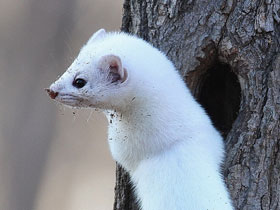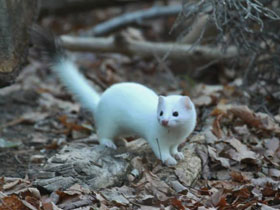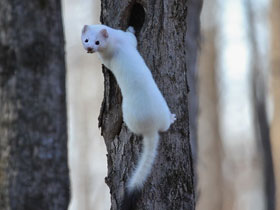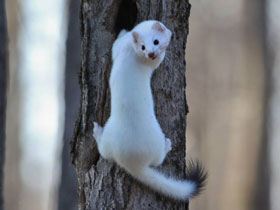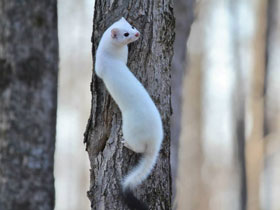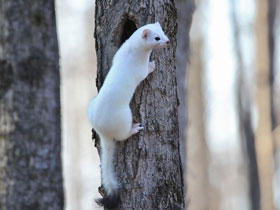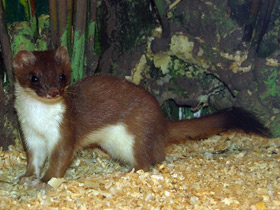The stoat or the Eurasian ermine, Beringian ermine and ermine (Mustela erminea)
The stoat (Mustela erminea), also known as the Eurasian ermine, Beringian ermine and ermine, is a mustelid native to Eurasia and the northern regions of North America. Because of its wide circumpolar distribution, it is listed as Least Concern on the IUCN Red List. It was introduced into New Zealand in the late 19th century to control rabbits, but had a devastating effect on native bird populations and was nominated as one of the world's top 100 "worst invaders".
The name ermine (/ˈɜːrmɪn/) is used for species in the genus Mustela, especially the stoat, in its pure white winter coat, or the fur thereof. Ermine fur was used in the 15th century by Catholic monarchs, who sometimes used it as the mozzetta cape. It has long been used on the ceremonial robes of members of the United Kingdom House of Lords. It was also used in capes on images such as the Infant Jesus of Prague.
Taxonomy
Formerly considered a single species with a very wide circumpolar range, a 2021 study split M. erminea into three species: M. erminea sensu stricto (Eurasia and northern North America), M. richardsonii (most of North America), and M. haidarum (several islands off the Pacific Northwest coast).
Habitat
Mustela erminea is a species of carnivorous mammal in the family Mustelidae.
Mustela erminea is a small but extremely aggressive animal of the polecat family. It is widespread in arctic, subarctic and temperate areas of Eurasia and North America. Mustela erminea inhabits both plains and mountains, in the Pamirs and Himalayas, ascending up to 3.5-4 thousand metres. The northern limit of Mustela erminea's range in Eurasia is delimited by the continental coast of the Arctic Ocean. In the south, the limits of Mustela erminea's distribution are set by the border of the subtropical zone. This predator prefers to settle in coastal forests, marshes, thickets and adjacent areas. Mustela erminea spends most of its life on the ground, although it is also a good tree climber and swimmer. It uses outcropping tree roots, hollow trunks and rodent burrows as dens.
Mustela erminea is most numerous in forest-steppe, taiga and tundra areas. Its choice of habitat is determined by the abundance of small rodents as its main food. As a rule, Mustela erminea prefers to settle near water: on the banks and floodplains of rivers and streams, near forest lakes, coastal meadows, thickets and reeds. Mustela erminea rarely ventures into forests; in woodlands it stays in old dwellings, clearings and glades. It avoids open spaces. Sometimes inhabits residential areas, fields, orchards and wooded areas, even on the outskirts of towns.
Appearance
An adult Mustela erminea has a total body length of 170-330 mm, with the tail accounting for approximately 35% of this length. Males grow to twice the size of females. The body shape of Mustela erminea is very similar to that of the weasel: long, ribbon-like, with short legs, a pointed snout and small ears. Its eyes are like black beads. Its coat is chocolate brown in summer and snow white in winter, except for the tip of the tail, which is black. The winter colouring is typical of areas with at least 40 days of snow.
Lifestyle and nutrition
Mustela erminea leads a predominantly solitary territorial lifestyle, marking the boundaries of an individual patch with the secretion of anal glands. Plot size varies from 10 to 20 ha; in males it is usually twice as large as in females and overlaps with their plots. Males and females live separately and only come together during the mating season. In years of famine and food shortage, Mustela erminea leave their territories and migrate, sometimes over considerable distances. Migrations are sometimes also triggered by massive rodent breeding in neighbouring areas.
Mustela erminea is mainly active at dusk and at night, but is sometimes found during the day. Mustela erminea is unpretentious in its choice of shelters, including breeding sites. It can be found in the most unexpected places, for example, in haystacks, piles of stones, in the ruins of abandoned buildings or in logs piled up against the wall of a house. Mustela erminea often occupies the burrows and nesting chambers of rodents it has killed. The female lays her breeding hole with the skins and hairs of dead rodents, and less often with dry grass. On her own, Mustela erminea does not dig burrows and uses random shelters, such as under stones, tree roots and logs.
Mustela erminea is a good swimmer and climber, but is essentially a specialised terrestrial predator. Its diet is dominated by rodents, but unlike the weasel, Mustela erminea hunts larger rodents, such as water voles, hamsters, squirrels, pikes, lemmings, etc., hunting them in burrows and under snow. Their size does not allow them to penetrate the burrows of smaller rodents. Females hunt in burrows more often than males. Birds and their eggs, as well as fish and shrews are of secondary importance in the diet of Mustela erminea. Even more rarely (in the absence of main food) Mustela erminea eats amphibians, reptiles and insects. It is capable of attacking larger animals, such as grouse, partridges, hares and rabbits; in years of famine, it even eats leftovers or robs people of their supplies of meat and fish. When food is plentiful, Mustela erminea hoards, destroying more rodents than it can eat. It kills its prey by biting the skull in the occipital region. Mustela erminea tracks rodents by scent, insects by sound and fish by sight. This small carnivore is very brave and bloodthirsty; in a desperate situation it may even pounce on a human.
Mustela erminea is very agile and dexterous, its movements are fast, but somewhat fussy. During a day's hunting it can cover 15 km, and an average of 3 km in winter. It jumps in the snow, up to 50 cm long, pushing the ground with both hind legs. This predator is an excellent swimmer and can easily climb trees. In pursuit of an enemy, it will often sit in a tree until the danger has passed. Mustela erminea is generally silent, but when excited it will bite loudly and may chirp, hiss and even bark.
Reproduction
Mustela erminea is polygamous and breeds once a year. Male sexual activity lasts 4 months, from mid-February to early June. Pregnancy in females has a long latency period (8-9 months). In total it lasts 9-10 months, so that the offspring appear in April-May of the following year. The number of offspring in a litter varies from 3 to 18, with an average of 4 to 9.
Newborn pups weigh between 3 and 4 g and measure between 32 and 51 mm. They are born blind, toothless, with closed ear canals and covered with sparse white wool. At 30-41 days, the young open their eyes and at 2-3 months are indistinguishable from adults. By the end of June, Mustela erminea hatchlings begin to forage for food on their own.
Females reach sexual maturity very early, at 2-3 months of age, while males reach sexual maturity at 11-14 months. Young females (at the age of 60-70 days) can be productively covered by adult males, a unique case among mammals, which contributes to the survival of the species.
The average lifespan of Mustela erminea is only 1-2 years, with a maximum of 7 years.
Fecundity and abundance of Mustela erminea fluctuate greatly, rising sharply in years of rodent abundance and falling catastrophically when rodents become extinct.
Subspecies
This is a list of stoat subspecies:
- Mustela erminea aestiva Kerr, 1792;
- Mustela erminea alascensis Merriam, 1896;
- Mustela erminea anguinae Hall, 1932;
- Mustela erminea arctica Merriam, 1896;
- Mustela erminea augustidens Brown, 1908;
- Mustela erminea bangsi Hall, 1945;
- Mustela erminea celenda Hall, 1944;
- Mustela erminea cicognanii Bonaparte, 1838;
- Mustela erminea erminea Linnaeus, 1758;
- Mustela erminea fallenda Hall, 1945;
- Mustela erminea ferghanae (Thomas, 1895);
- Mustela erminea gulosa Hall, 1945;
- Mustela erminea haidarum Preble, 1898;
- Mustela erminea hibernica Thomas and Barrett-Hamilton, 1895;
- Mustela erminea initis Hall, 1945;
- Mustela erminea invicta Hall, 1945;
- Mustela erminea kadiacensis Merriam, 1896;
- Mustela erminea kaneii (Baird, 1857);
- Mustela erminea karaginensis Jurgenson, 1936;
- Mustela erminea lymani Hollister, 1912;
- Mustela erminea martinoi Ellerman and Morrison-Scott, 1951;
- Mustela erminea minima Cavazza, 1912;
- Mustela erminea mongolica Ognev, 1928;
- Mustela erminea muricus Bangs, 1899;
- Mustela erminea nippon Cabrera, 1913;
- Mustela erminea ognevi Jurgenson, 1932;
- Mustela erminea olympica Hall, 1945;
- Mustela erminea polaris Barrett-Hamilton, 1904;
- Mustela erminea richardsonii Bonaparte, 1838;
- Mustela erminea ricinae Miller, 1907;
- Mustela erminea salva Hall, 1944;
- Mustela erminea seclusa Hall, 1944;
- Mustela erminea semplei Sutton and Hamilton, 1932;
- Mustela erminea stabilis Barrett-Hamilton, 1904;
- Mustela erminea streatori Merriam, 1896;
- Mustela erminea teberdina Kornejev, 1941;
- Mustela erminea tobolica Ognev, 1923.
Predators
Larger mammalian predators such as red foxes (Vulpes vulpes) and sables (Martes zibellina) are known to prey on stoats. Additionally, a wide range of birds of prey can take stoats, from small northern hawk-owls (Surnia ulula) and short-eared owls (Asio flammeus) to various buzzards, kites, goshawks, and even Eurasian eagle-owls (Bubo bubo) and golden eagles (Aquila chrysaetos). Although not classified as birds of prey, grey herons (Ardea cinerea) are known to prey on stoats.
Diseases and parasites
Tuberculosis has been recorded in stoats inhabiting the former Soviet Union and New Zealand. They are largely resistant to tularemia, but are reputed to suffer from canine distemper in captivity. Symptoms of mange have also been recorded.

















